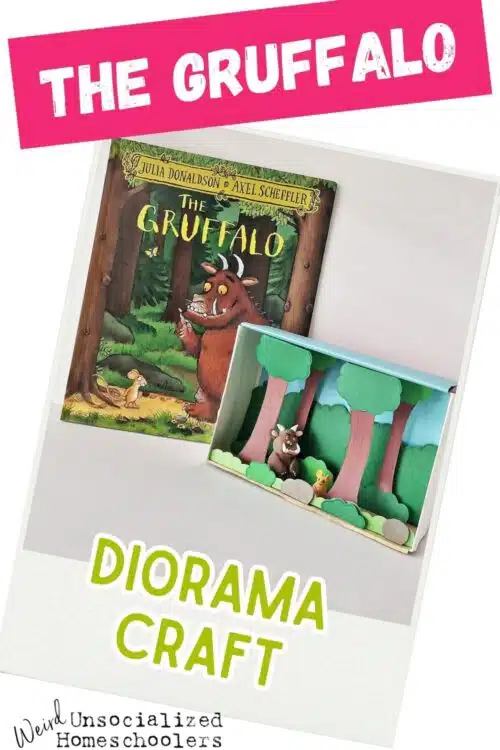The Gruffalo Diorama Craft & Mini Unit Study
Have you and your kids read The Gruffalo? Written by Julia Donaldson and illustrated by Axel Scheffler, the charming storybook tells the tale of a mouse exploring the woods and encountering some surprising characters.
The engaging story also offers a wonderful opportunity to bring literature to life for children through creative activities, and we’ve got a terrific craft: The Gruffalo diorama! In this post, you’ll find a template, step-by-step instructions, photos, as well as video instructions for making a diorama of a scene from The Gruffalo.
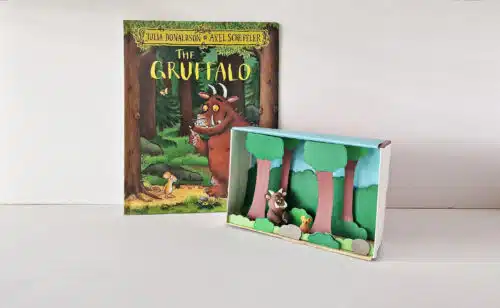
Before jumping into The Gruffalo diorama, let’s explore how you can use a story like “The Gruffalo” to not only entertain your children but also engage their minds and curiosity, hopefully sparking a lifelong love for learning.
How to Bring Literature to Life
One of the most effective ways to engage children with literature is to make the story come alive through hands-on activities that make learning fun. Dioramas provide a perfect medium for this, allowing children to recreate scenes from the book using their imagination and creativity.
With The Gruffalo diorama craft, children can visualize the story in a three-dimensional space, bringing the story to life and letting them partake in the fun of creating something that enhances their understanding.
Create Learning Opportunities for Older Children
While The Gruffalo is a picture book aimed at younger children, it offers plenty of opportunities for older children to engage with the story on a deeper level. For example, older kids can
- Analyze the characters’ motivations and actions
- Discuss the themes of friendship and bravery
- Compare and contrast the book with other stories they’ve read
A few recommended books for comparing characters, storylines, and settings are:
- The Snail and the Whale by Julia Donaldson
- The Tiger Who Came to Tea by Judith Kerr
- Peace at Last by Jill Murphy
- Dragons Love Tacos by Adam Rubin
- The Storm Whale by Benji Davies
You can give older kids a writing assignment such as writing their creative interpretation of the story or writing an alternative ending for further literature and free-writing practice.
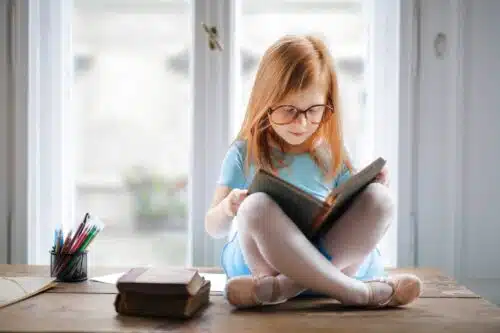
Have your middle-grade children research the animals featured in the book, turning the project into an expanded science study.
As you create The Gruffalo diorama, you have the option of using premade figurines from the story, or your kids can try their hand at creating the Gruffalo and the mouse out of clay. This is a terrific art exercise for children young and old, and another way to expand this project.
Fostering a Love for Learning
Projects like The Gruffalo diorama not only make learning enjoyable but also instill a love for reading and exploration in children. By encouraging them to immerse themselves in the world of the story and express their creativity through art and writing, we can nurture their curiosity and enthusiasm for learning. This kind of engagement with literature sets the stage for a lifelong love of reading as well, which is a valuable skill that will benefit them throughout their lives.
The Gruffalo Diorama Project
After these steps and accompanying images, you will find a series of short videos showing you the steps for making The Gruffalo diorama.
List of Supplies
- A box (at least 3 inches deep)
- Template (for 7” X 5” box)
- Colored cardstock paper
- Pencil – for tracing template
- A pair of scissors
- Craft glue
- Figurines of the Gruffalo and the Mouse (or handmade, with crafting clay)
- Sharpies (optional)
Crafting The Gruffalo Diorama
Step 1:
To get started, we need to select a scene from the storybook. If this is your first diorama project, try selecting a simple or easy-to-recreate scene from the storybook. You can easily follow The Gruffalo diorama template provided here.

Step 2:
Make a draft sketch of the scene for the craft. If you’re doing this project with your kids, have them practice their sketching by copying the pencil sketch below.
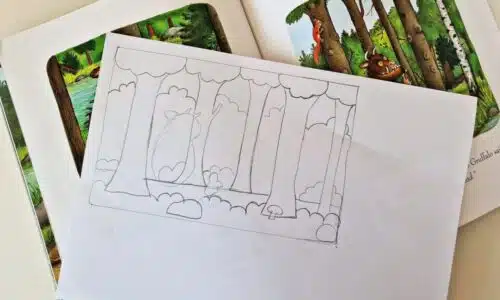
Step 3:
Select colored cardstock papers for the craft. Since we’re creating a forest scene, select different shades of green cardstock papers along with blue (for the sky background), brown and light brown (for the tree trunks and ground), and grey (for the rocks).
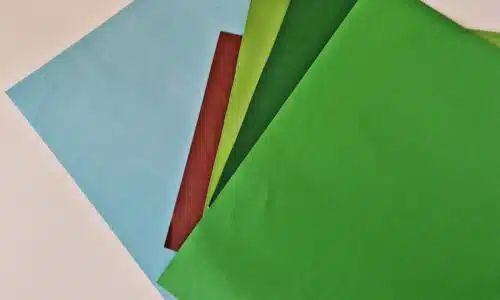
Step 4:
Use the template to trace the patterns on the selected cardstock papers and then cut them out nicely.

Step 5:
Glue the green cutouts of the treetops to the brown trunk cutouts to complete the tree patterns. For this craft, you’ll be using a total of 4 trees: 2 for the front layer and 2 for a layer that goes behind.
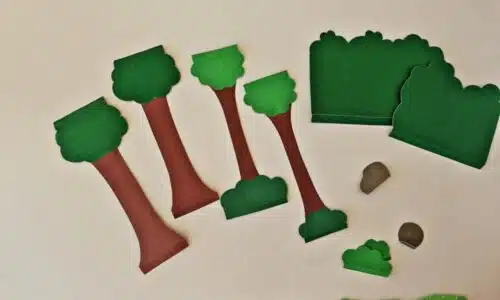
Step 6:
Select a box of roughly 7 inches x 5 inches with 3 inches depth. Cover the inner base and one of the sides of the box with blue paper for the sky layer. Cover the other inner side with light brown paper for the ground.

Step 7:
Make thin folds along the bottom side of the bush layers and apply glue along the thin part. Attach the bush layers roughly a cm from the base of the box. Attach the items to the “ground” of the scene.
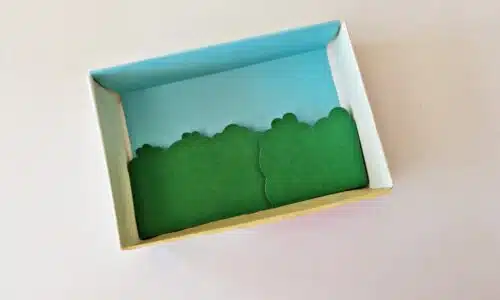
Step 8:
Make thin folds along the bottom side and top side of the tree patterns and glue them to the front side of the bush layers. Keep 1 or 2 cm gap between the layers.

Step 9:
Attach some smaller bush cutouts near the trees.

Step 10:
Now, glue the front layer of trees and then the front grass layer. You can adjust the height of the grass layers by cutting the pattern along the bottom side.
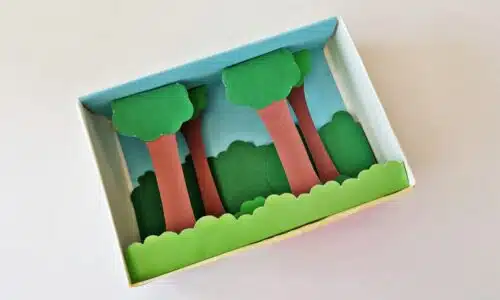
Step 11:
Now it’s time to prepare your characters! As mentioned earlier, you can use craft clay to make clay figures of the Gruffalo and the mouse, or you can use store-bought figures.

Step 12:
An optional step here is to add borders and details to each item, such as the trees and bushes, using Sharpies.
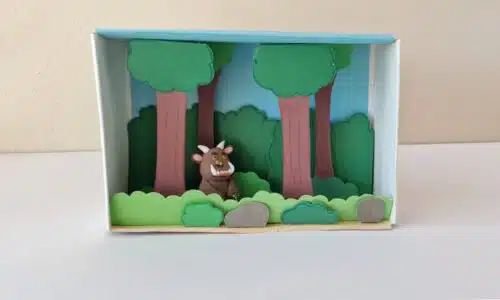
Step 13:
Place the clay figures inside the box to complete The Gruffalo diorama scene.
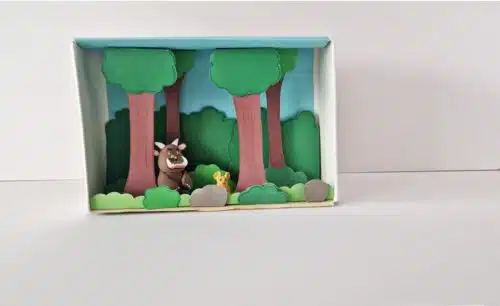
Video Instructions for The Gruffalo Diorama
Video One:
Video Two:
Video Three:
Video Four:
Video Five:
Video Six:
We hope you enjoyed this fun craft and additional activities!
Bringing literature to life through projects like The Gruffalo diorama is a powerful way to captivate young minds and inspire a passion for learning. By providing our children with opportunities to engage with stories in creative and meaningful ways, we can help them develop important skills and attitudes that will serve them well as they continue to grow.
Keep your eye out for more story-based dioramas in the months to come!
You Might Also Enjoy:
- 20+ Ways to Make Your Homeschool More Fun This Year
- Literature-Based Homeschooling Is Not Scary
- Free Literature Activities, Lessons, and Printables
Bonita Jewel visited India when she was 16 and stayed for 12 years. She holds an MFA in Creative Writing and has worked as a freelance writer and editor for 13 years. Now settled in California with her husband and three children, Bonita's writing explores faith, family, belonging, and of course, the joys of writing, reading, and finding oneself part of a Greater Story. Find her at bonitajewel.com and bonitajewel.substack.com







